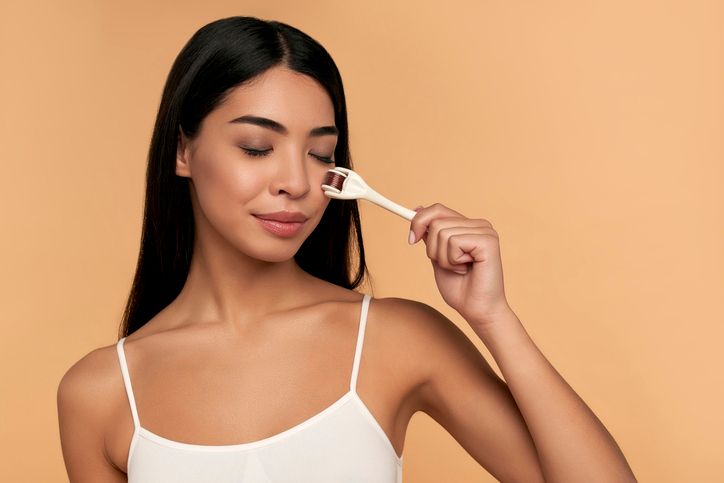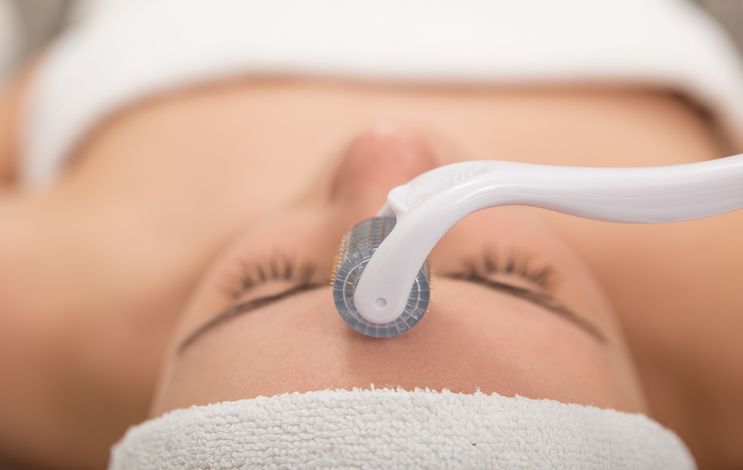- Home
- Trend
- Weight Loss Strategies
- Acne Tips
- Hair Health Information
- Blemish Removal Tips
- Acne Scar Removal Tips
- Muscle Building Techniques
- Intimate Care Tips
- Postpartum Intimate Care
- Eye Bags Wiki
- Tips for Face Slimming
- Secret of Permanent Hair Removal
- Breast Enlargement Tips
- Cure to Snoring
- Marionette Lines
- Skin-Tightening Secrets
Though it's often used on the face, derma rollers can also help with issues like dark spots, cellulite, and stretch marks, check out how to use them now.
What Is a Derma Roller?

The derma roller is a recent trend in skincare. It features a rolling head covered in tiny needles, which create micro-injuries on the skin when rolled over the surface. While it may sound a bit scary, this technique is actually a natural therapy based on stimulating the body’s self-healing mechanisms to achieve beautifying effects. Though it's often used on the face, derma rollers can also address issues on other areas of the body, such as dark spots, cellulite, and stretch marks. The micro-injuries caused are minimal and not harmful to the skin—in fact, they can speed up skin repair and help your skin look smoother and more radiant in less time.
How Do Derma Rollers Work?

Many people think that beauty sometimes requires a bit of pain, but derma rolling seems extreme—doesn’t it pose risks? While it can seem intimidating, the derma roller is far from a gimmick. It operates based on principles entirely different from ordinary skincare methods. Also known as “collagen induction therapy,” this treatment triggers a heightened state of alert in the skin through controlled stimulation, enhancing its repair and healing abilities. As the dermis heals from the micro-injuries, the skin’s collagen and elastin production ramps up, and skin cell activity becomes healthier and more dynamic. This process not only flushes out toxins but also makes the skin far more receptive to the nutrients in your skincare products. That’s why many people find their skincare routine becomes much more effective after using a derma roller.
免費體驗
Acne Treatment
1 Minute Self-Registration
Date should not be before minimal date
Is It Safe for Everyone to Use a Derma Roller?
Despite its popularity, derma rolling isn’t suitable for everyone—especially not all skin types. If your skin is prone to instability—frequent acne breakouts, redness, itchiness, or flaking—you should avoid using a derma roller. Sensitive skin types are particularly at risk. Similarly, individuals with chronic skin conditions or those using certain medications (topical or oral) should steer clear unless they consult a dermatologist first. If your facial skin is visibly irritated or inflamed, it’s better to try alternative skin-smoothing methods. Derma rolling is only appropriate once your skin is in a stable and healthy state.
7 Skin Benefits of Derma Rolling: Does It Really Help with Whitening and Wrinkles?
1. Boosts Product Absorption:
Derma rolling significantly improves the skin’s ability to absorb skincare products. By triggering skin renewal and detoxification, it clears blockages in the pores and makes it easier for the skin to take in active ingredients. This is why post-treatment care is so important—your skin is not only sensitive at this stage, but also in a prime state to absorb serums, moisturizers, and other nourishing products.
2. Relieves Dryness:
Micro-needling helps combat dryness by encouraging the production of collagen and elastin, which are vital for hydration and firmness. While these substances are naturally present in the skin, their levels drop rapidly after the age of 25. Derma rolling is a direct and effective way to restore skin moisture and elasticity.
3. Fades Scars and Blemishes:
If you’re prone to scarring, derma rolling can help by creating micro-channels in the skin that trigger the repair process. This stimulates fibroblast activity and enables the infusion of growth factors, either through dissolvable microneedles or specialized serums, to repair acne scars, pitted skin, and other blemishes.
4. Reduces Pigmentation:
Derma rolling also tackles pigmentation issues, such as dark spots and under-eye circles. By accelerating the turnover of melanin and dispersing concentrated pigment clusters, it helps fade spots and brighten the overall complexion.
5. Smooths Fine Lines and Wrinkles:
Fine lines often result from dehydrated, sagging skin. Derma rolling firms up the skin by improving hydration and restoring elasticity. If you notice creases around your eyes or nose even when you're not smiling, it might be time to address early signs of aging with a derma roller.
6. Brightens and Evens Skin Tone:
In addition to reducing pigmentation, derma rolling also exfoliates the outermost skin layers, removing dull, toxin-laden cells. This enhances your skin’s natural radiance and evens out tone, replacing sallow, uneven skin with a luminous glow.
7. Minimizes Enlarged Pores:
If your pores are visibly large—resembling strawberry skin—derma rolling may help. The treatment strengthens the skin’s structure, making pores less likely to stretch or remain clogged. It also helps clear sebum buildup, reducing the chance of further pore enlargement or damage from environmental irritants.
Are There Side Effects from Using a Derma Roller?
1. Redness and Itching
While derma rolling can smooth your skin in a short time, not everyone has the skill or training to ensure a flawless experience. The most common side effects are temporary reactions such as redness and itching. With so many microneedles sweeping across your face and creating tiny punctures, this response is entirely normal—it signals that your skin is on high alert and reacting to the stimulation. In fact, these reactions kickstart your body’s defense and repair mechanisms, so once they subside, you’re likely to see a noticeable improvement in skin texture.
2. Risk of Hyperpigmentation
Some people get frustrated when they experience temporary darkening (known as the “post-treatment dark phase”) after using a derma roller. Emotional stress can disrupt your hormonal balance, worsening this temporary pigmentation into more permanent discoloration. In reality, this reaction is part of the skin’s natural healing process. Intense derma rolling may temporarily increase tyrosinase activity (an enzyme linked to melanin production), leading to pigmentation—but this usually fades within two weeks.
3. Shingles (Herpes Zoster)
Shingles can appear anywhere on the body, including the face after microneedling. Many users report breakouts of shingles around the lips post-treatment. The concerning part is that the infection may spread if not treated promptly, potentially affecting other areas of the face.
4. Dermatitis
Any of the above side effects, if left untreated, can escalate into dermatitis. While we often hear about skin inflammation, imagine it happening on your face—that’s far more distressing. If you notice an excessive reaction after using a derma roller, consult a doctor immediately. Otherwise, worsening infection may require intensive treatment with both topical and oral medications.
免費體驗
Acne Treatment
1 Minute Self-Registration
Date should not be before minimal date
How to Choose a Derma Roller: Follow These Key Guidelines
How to Choose the Number of Needles
Derma rollers come in various needle counts, from as few as 180 to as many as 1,000. The most common versions on the market include 192, 540, and 600 needles. This refers to the total number of microneedles on the roller head. If you’re new to derma rolling and worried about pain, start with a 540- or 600-needle roller—these have denser needle spacing, which helps distribute pressure and reduces discomfort. In contrast, 192-needle rollers tend to be sharper and more painful, with a higher chance of causing bleeding.
How to Choose the Needle Length
Derma roller needles range from 0.2 mm to 3 mm in length. For beginners, a 0.5 mm roller is a safe and effective choice. It’s sufficient for most beauty goals without penetrating too deeply. However, be sure to control your pressure during use—otherwise, you might trigger some of the side effects mentioned above.
Manual vs. Electric Derma Rollers
Though both are considered derma rollers, the manual and electric versions are quite different. Manual rollers rely entirely on the user’s hand pressure, so it’s harder to control needle depth. Electric derma rollers are more user-friendly—some models even offer adjustable needle lengths and interchangeable heads. While the tactile feel varies, both versions provide similar skin-smoothing benefits. Simply choose the one that suits your preferences and comfort level.
How to Use a Derma Roller Step by Step
Step 1: Cleanse Your Face
Like all skincare treatments, start with a clean face. Use a gentle cleanser that won’t overly dry your skin.
Step 2: Disinfect the Roller
Before use, rinse the roller head with warm water. You can also soak it in 95% alcohol for 20 minutes, then let it air dry completely before proceeding.
Step 3: Apply Numbing Cream
To minimize discomfort, apply a topical numbing cream to the treatment area. Alternatively, you can use a hyaluronic acid serum or facial essence instead.
Step 4: Start Rolling
Hold the roller handle vertically and gently roll it back and forth over each target area 5 to 10 times. Maintain consistent pressure and avoid excessive rolling.
Step 5: Post-Treatment Care
Focus on hydration and sun protection after the procedure. Avoid using any acidic products (like AHAs or BHAs) that may irritate your skin.
Hottest 2023 Treatment: Perfect Medical Acne Solution—Painless, Easy Blemish Removal!
Worried that derma rolling is too painful or risky? There’s a safer, more effective way to achieve smooth skin! Check out the 100% safe, painless, and non-invasive Perfect Medical Acne Treatment. Not only does it clear up acne, but it also tackles other annoying skin issues like blackheads, whiteheads, and enlarged pores—leaving your skin completely flawless!
This signature treatment focuses on transforming acne-prone skin. It starts with a dual-action spiral suction system that deeply cleanses the skin by extracting oil and debris from beneath the surface. Then, your skin is infused with world-class hydrating serums to nourish and plump from within—leaving your face looking as youthful and dewy as ever.
Because this treatment is non-invasive, it’s suitable for all skin types and doesn’t come with the side effects commonly associated with derma rolling. Plus, our professional team provides follow-up support, so you won’t have to worry about acne returning. Register now to get a full package that includes a professional skin analysis and Perfect Medical Acne Treatment, and receive a free brightening and hydrating mask by liking our Facebook page. Slots are limited—don’t miss out!
Try the Perfect Medical Acne Treatment Now!免費體驗
Acne Treatment
1 Minute Self-Registration
Date should not be before minimal date
FAQ

How often should I use a derma roller?
Once a week is recommended.
How long until I see results?
Typically, results show after one month.
Does derma rolling hurt?
It won’t hurt if you apply numbing cream beforehand.
Is a derma roller effective?
Effectiveness varies by skin type.
What can microneedling treat?
It can improve acne scars, pigmentation, and body stretch marks.









